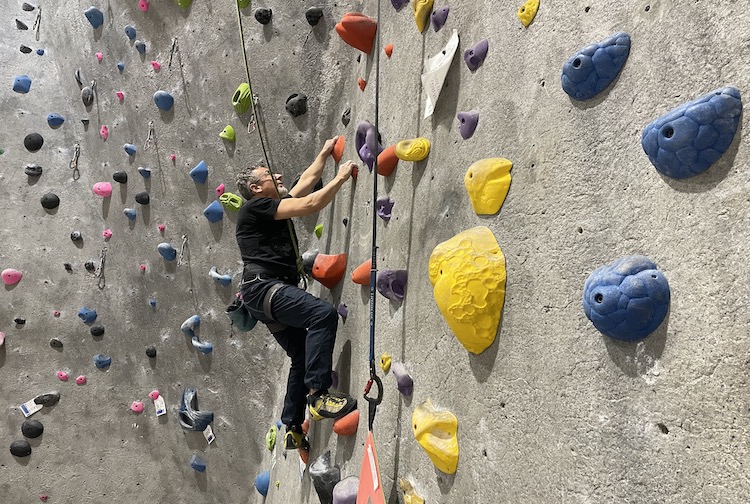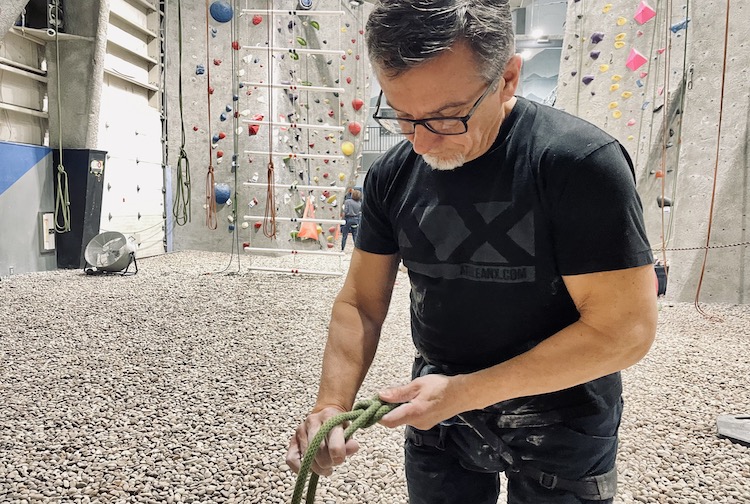Patients with Parkinson's disease hit the wall to improve mind and body
By Jeff Kelley
Mike Hoyt ties into his harness and is connected, by that rope, to the top of a wall some 50 feet high. He places one foot on the wall, then one hand, the other foot, now the other hand, and maneuvers his way to the top before letting go and being brought slowly down to earth by a belayer.
You would never know Hoyt is a face of Parkinson’s disease (PD), and has been one since December 2013.
“I tried not to look at what I couldn't be doing,” the now 67-year-old said on his diagnosis, standing on the floor of Midlothian’s Peak Experiences rock climbing gym. At home in Williamsburg, he began exercising more and working with a personal trainer, before actually becoming a certified personal trainer himself as a retirement gig. The former Newport News engineer trained numerous clients and even a few with PD.
In the last year, Hoyt added rock climbing to his daily exercise regimen.
“When you’re on the wall, there’s a focus. You don’t think,” he said, his voice breaking. “You don’t think about your limitations. You set goals for yourself, and work to achieve them.”
Mike Hoyt is part of the growing Virginia-based nonprofit Up ENDing Parkinson’s, which promotes the benefits of climbing for those with Parkinson’s disease. The group is a partner of the VCU Parkinson’s & Movement Disorders Center. (Jeff Kelley)
The Richmond rock climbing program is a chapter of the growing Virginia-based nonprofit Up ENDing Parkinson’s. The group, which promotes the benefits of climbing for those with PD, was started by Molly Cupka, a climbing instructor and director at Sportrock Climbing Centers in Northern Virginia who began climbing with PD patients in 2012.
“I am convinced that rock climbing is the most comprehensive exercise a person with Parkinson’s disease can do,” she said.
Cupka cites recommendations from the Parkinson’s Foundation and American College of Sports Medicine on the best types of exercise for PD — aerobic activity, strength training, balance/agility/multitasking and stretching — and notes climbing “checks all the boxes.”
Hoyt found Cupka while searching online in February 2022. He traveled to Sportrock in Alexandria for several months before they connected with Margaret Preston, president of Richmond-based Power Over Parkinson’s, to replicate the climbing program in Richmond. Weekly events are now held at Peak under an additional partnership with a team from Beyond Boundaries, a Central Virginia nonprofit helping individuals with disabilities, underserved youth, and those in recovery to get active. Richmond is Up ENDing Parkinson’s second outpost, and it has added others in Asheville, N.C., Ohio, and Italy. The group is also a partner of the VCU Parkinson’s & Movement Disorders Center.
For those living with PD, exercise is vital to maintaining balance, mobility and activities of daily living. The Parkinson’s Foundation notes research supports that people with PD who start exercising earlier in their disease course for a minimum of 2.5 hours per week experience a slowed decline in quality of life compared to those who start later.
Exercise and physical activity can not only maintain and improve mobility, flexibility and balance, but can also ease non-motor PD symptoms such as depression or constipation. It’s well established in the field of Parkinson’s research that exercise is the single most important method of not only improving, but also slowing, symptoms.
“It is the only thing we believe that has been proven to slow disease progression,” Leslie Cloud, M.D., an associate professor of neurology and director of the Parkinson’s Disease Program at the VCU Parkinson’s & Movement Disorders Center, said.
The VCU Parkinson’s and Movement Disorders Center is one of only 37 centers in the U.S. and 51 medical centers worldwide recognized by the Parkinson’s Foundation as a Center of Excellence. VCU’s Center, the only one of its kind in Virginia, combines research, clinical evaluation and treatment, education and outreach to provide a coordinated approach for developing strategies that combat movement disorders. The multidisciplinary center also moves research from novel approaches in the laboratory to clinical trials, which translates into real-world treatments.
Whether rock climbing or boxing — as many with Parkinson’s take up — the key is getting the heart rate up with aerobic exercise.
“You can’t mosey along and walk the dog, you have to be sweating, and get your cardiac output up,” said Cloud, who has been Hoyt’s PD specialist since 2014. “The mechanism is that by getting your heart rate up, you increase blood flow to the brain, and that brings all sorts of good downstream benefits that keep brain cells happy and healthy and alive for longer.” She encourages at least 150 minutes of such exercise each week.
Mike Hoyt was diagnosed with Parkinson’s disease in December 2018. He has since taken up rock climbing to help maintain maintaining balance and mobility. (Jeff Kelley)
In theory, Cloud says, there are benefits specific to rock climbing. Climbing requires large-amplitude movements with all four limbs. Fingers must move in novel ways to grasp colorful holds of random size and shape that are bolted to the wall. Balance and core strength is critical to success.
“And then there’s kind of a meditative, mind-over-matter element to the whole thing,” Cloud said.
Indeed for Hoyt, rock climbing is but one element in his life to take his mind off the disease — he eats well, gets in his exercise, and stays positive.
“The encouragement, support and friendships you develop with your fellow climbers, the individuals who volunteer their time to belay and coach you and people you meet in the climbing community motivate you to continue to challenge yourself and to keep moving, in spite of what your PD symptoms are telling you,” Hoyt said.

